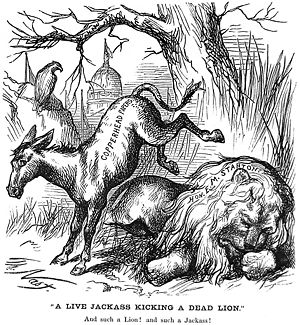 Image via Wikipedia
Image via Wikipedia
Parties are the most important organizations that control the resources of a nation. In the United States, two conflicting and competing political parties, the Republican Party and the Democratic Party, have been the torchbearers of the nation for many years (Belloni and Beller, 1976). Because these two political parties have been dominating American political arena for such a long time, the prospect of smaller parties emerging in a landslide victory have always been hampered by the domineering tactics of the bigger parties. It is common for political parties to align themselves with interest groups such as religious and secular organizations for the sake of emerging the majority party in the electoral process. A presidential hopeful may give a lecture at an institution or before a church that has a large following simply to garner support as did former president Ronald Reagan at Jerry Falwell’s Liberty Baptist College in 1980 (Williams, 2010).
Political parties play vital roles in the democratic process by injecting new ideas and implementing viable projects that they deem beneficial to the nation’s social, economic, and political wellbeing. Because members of political parties are accountable to the voting public, they have to avoid removal from office at all cost by making valuable contributions to the society they represent. As opposed to the clangorous Indian, Turkish, Taiwanese, and Somali parliamentary debates known for political pugilism , the United States political party deliberations always convene in peaceful atmospheres.
References
Belloni, F. P., & Beller, D. C. (1976). The study of party factions as competitive political organizations. Political Research Quarterly, 29(4), 531–549.
DiSalvo, D. (2010). The Politics of a Party Faction: The Liberal Labor Alliance in the Democratic Party, 1948–1972. Journal of Policy History, Vol. 22 Issue 3, 269.
Williams, D. K. (2010). Jerry Falwell’s Sunbelt Politics: The Regional Origins of the Moral Majority. Journal of Policy History, Vol. 22, No. 2, 126.


No comments:
Post a Comment